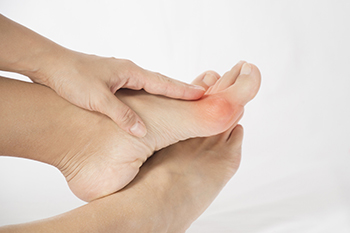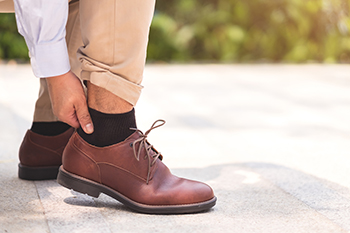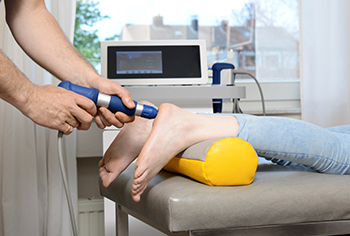
Bunions are a particular kind of bony bump that can form on the outside of the joint of the big toe or small pinky toe. It is important to note that some types of bunions can cause pain in individuals, while others do not. In this sense, a bunion can be a cosmetic issue for some patients. There are several steps that a patient can consider taking to prevent the formation of bunions. For example, an individual can be mindful of the shoes that they are wearing. Particularly tight shoes can lead to bunions developing. Instead, an individual can be sure to wear shoes that are spacious and comfortable. Secondly, an individual might be able to prevent the development of bunions by doing what they can to stop overpronation. Importantly, overpronation can occur when the foot rolls inward. Orthotics may be used to correct this. If you are someone that is struggling with bunions, it is suggested that you contact a podiatrist today for treatment.
If you are suffering from bunions, contact Leonora Fihman, DPM of California. Our doctor can provide the care you need to keep you pain-free and on your feet.
What Is a Bunion?
A bunion is formed of swollen tissue or an enlargement of boney growth, usually located at the base joint of the toe that connects to the foot. The swelling occurs due to the bones in the big toe shifting inward, which impacts the other toes of the foot. This causes the area around the base of the big toe to become inflamed and painful.
Why Do Bunions Form?
Genetics – Susceptibility to bunions are often hereditary
Stress on the feet – Poorly fitted and uncomfortable footwear that places stress on feet, such as heels, can worsen existing bunions
How Are Bunions Diagnosed?
Doctors often perform two tests – blood tests and x-rays – when trying to diagnose bunions, especially in the early stages of development. Blood tests help determine if the foot pain is being caused by something else, such as arthritis, while x-rays provide a clear picture of your bone structure to your doctor.
How Are Bunions Treated?
If you have any questions, please feel free to contact our offices located in Encino and Brentwood, Los Angeles, CA . We offer the newest diagnostic and treatment technologies for all your foot care needs.

The onset of warm weather in many parts of the world may bring the desire to lose the shoes and walk barefoot. It can be interesting to look closely at the feet, which is often done during the day while the shoes are off. Each foot has 26 bones, several tendons, muscles, and ligaments that work together to make the foot move. The joints in the feet enable the bones to change position, and they are held together by portions of tissues that are stretched between the bones. The soles of the feet have thicker skin than the rest of the body, and they are designed to absorb the weight of the body. The various components of the feet work together to balance and support the body, in addition to providing the ability to move from place to place. If you would like additional information about how the feet are designed, it is suggested that you consult with a podiatrist who can provide you with the information you are seeking.
If you have any concerns about your feet, contact Leonora Fihman, DPM from California. Our doctor can provide the care you need to keep you pain-free and on your feet.
Biomechanics in Podiatry
Podiatric biomechanics is a particular sector of specialty podiatry with licensed practitioners who are trained to diagnose and treat conditions affecting the foot, ankle and lower leg. Biomechanics deals with the forces that act against the body, causing an interference with the biological structures. It focuses on the movement of the ankle, the foot and the forces that interact with them.
A History of Biomechanics
Modern technological improvements are based on past theories and therapeutic processes that provide a better understanding of podiatric concepts for biomechanics. Computers can provide accurate information about the forces and patterns of the feet and lower legs.
Understanding biomechanics of the feet can help improve and eliminate pain, stopping further stress to the foot.
If you have any questions please feel free to contact our offices located in Encino and Brentwood, Los Angeles, CA . We offer the newest diagnostic and treatment technologies for all your foot and ankle needs.

Metatarsalgia is the medical name for pain that happens to the ball of the foot. It is found under the toes, on the bottom of the foot. The feet bear the weight of the body, and the soles of the feet are often affected. There are 26 bones in each foot, and they are divided into categories. Additionally, the tendons, muscles, and ligaments comprise the arch of the foot, and the nerves control the sensation in the skin. There are several reasons why many people experience metatarsalgia, or foot pain. These can include obesity, wearing shoes that do not fit correctly, or specific medical conditions. Morton’s neuroma can happen from wearing shoes that are too tight, such as high heels. This can cause the toes to squeeze together, affecting the nerve that is located between the third and fourth toes. The pain from this condition is often felt in the ball of the foot. A stress fracture can happen to the metatarsal bones in the foot, and it can be felt in the bottom of the foot. If you have foot pain, it is suggested that you seek the counsel of a podiatrist who can effectively diagnose and treat the condition appropriately.
Foot Pain
Foot pain can be extremely painful and debilitating. If you have a foot pain, consult with Leonora Fihman, DPM from California. Our doctor will assess your condition and provide you with quality foot and ankle treatment.
Causes
Foot pain is a very broad condition that could be caused by one or more ailments. The most common include:
Diagnosis
To figure out the cause of foot pain, podiatrists utilize several different methods. This can range from simple visual inspections and sensation tests to X-rays and MRI scans. Prior medical history, family medical history, and any recent physical traumatic events will all be taken into consideration for a proper diagnosis.
Treatment
Treatment depends upon the cause of the foot pain. Whether it is resting, staying off the foot, or having surgery; podiatrists have a number of treatment options available for foot pain.
If you have any questions, please feel free to contact our offices located in Encino and Brentwood, Los Angeles, CA . We offer the newest diagnostic and treatment technologies for all your foot care needs.

There are various ways to determine your shoe size and ensure a proper fit. Using a Brannock device is an effective measuring tool that is found in most shoe stores. However, many people opt to know their shoe size before going to the store and this can be accomplished at home. The first step is to trace the foot on a piece of paper while wearing the intended socks. This is followed by using a size conversion chart and matching the length of the traced foot to its corresponding size. When a shoe fits properly, there is adequate room for the toes to move freely, and the heel and midfoot fit snugly. It is beneficial to measure the feet each time new shoes are purchased. The best time of day to measure the feet is in the afternoon when the feet are at their largest. If you would like more information on how to find shoes that fit properly, please speak with your local podiatrist.
Finding a properly-fitting shoe is important in reducing injuries and preventing foot problems. For more information about treatment, contact Leonora Fihman, DPM from California. Our doctor will treat your foot and ankle needs.
Proper Shoe Fitting
A common concern when it comes to foot health, having properly fitted shoes can help prevent injuries to the foot. Out feet affect our posture and gait, which in turn affects the biomechanics and overall bodily structure. With 33 joints, 26 bones, and over 100 ligaments, the potential for serious injury is much greater than one realizes. Although the feet cease growth in adulthood, they still change shape as they mature. Here are some factors to consider when it comes to investing in proper fitting shoes:
Keeping in mind how shoes fit the biomechanics of your body, properly-fitting shoes are vitally important. Fortunately, it is not difficult to acquire footwear that fits correctly. Be sure to wear shoes that support the overall structure of your body. Do your feet a favor and invest in several pairs of well-fitted shoes today.
If you have any questions please feel free to contact our offices located in Encino and Brentwood, Los Angeles, CA . We offer the newest diagnostic and treatment technologies for all your foot and ankle needs.

Patients who have developed plantar fasciitis often look to find relief. It is a condition that is characterized by heel pain, and it may affect the Achilles tendon. Plantar fasciitis is an inflammation of the plantar fascia, which is the band of tissue that connects the heels to the toes. It is located on the soles of the feet, and can happen from standing on hard surfaces for the majority of the day. Additionally, wearing shoes that do not have adequate support may contribute significantly to getting plantar fasciitis. Many people choose to ignore the aches that this condition often begins with, and this may extend the recovery period. There are simple stretching techniques that may help to reduce the pain from plantar fasciitis. A stretch for the plantar fascia is done by rolling the affected foot on a tennis ball or frozen water bottle. A standing heel raise is also an effective stretch. This is accomplished by standing on a step, while lowering heels one at a time until a gentle stretch is felt. Plantar fasciitis is a serious foot condition, and it is suggested that you are under the care of a podiatrist who can help you with effective relief methods.
Plantar fasciitis is a common foot condition that is often caused by a strain injury. If you are experiencing heel pain or symptoms of plantar fasciitis, contact Leonora Fihman, DPM from California. Our doctor can provide the care you need to keep you pain-free and on your feet.
What Is Plantar Fasciitis?
Plantar fasciitis is one of the most common causes of heel pain. The plantar fascia is a ligament that connects your heel to the front of your foot. When this ligament becomes inflamed, plantar fasciitis is the result. If you have plantar fasciitis you will have a stabbing pain that usually occurs with your first steps in the morning. As the day progresses and you walk around more, this pain will start to disappear, but it will return after long periods of standing or sitting.
What Causes Plantar Fasciitis?
There are some risk factors that may make you more likely to develop plantar fasciitis compared to others. The condition most commonly affects adults between the ages of 40 and 60. It also tends to affect people who are obese because the extra pounds result in extra stress being placed on the plantar fascia.
Prevention
There are a variety of treatment options available for plantar fasciitis along with the pain that accompanies it. Additionally, physical therapy is a very important component in the treatment process. It is important that you meet with your podiatrist to determine which treatment option is best for you.
If you have any questions, please feel free to contact our offices located in Encino and Brentwood, Los Angeles, CA . We offer the newest diagnostic and treatment technologies for all your foot care needs.

People who have jobs that require standing for most of the day may have sore feet. The feet absorb the body’s weight, and achiness may happen faster when incorrect shoes are worn. The body may have difficulty moving the blood from the feet to the heart, which may cause the feet and ankles to become swollen. The overall body can benefit when the feet are elevated as often as possible, and this can be done during a lunch or resting break. Many employers provide their employees with stress mats, which can provide adequate cushioning to protect the feet. Additionally, it is imperative to wear shoes that fit properly, preferably with a low heel. Many people enjoy soaking their feet in warm water at the end of the workday, which may help to improve circulation. If you would like more information about how to protect your feet while working, it is suggested that you confer with a podiatrist who can provide you with helpful tips.
While working on the feet, it is important to take the proper care of them. For more information about working on your feet, contact Leonora Fihman, DPM from California. Our doctor will treat your foot and ankle needs.
Working on Your Feet
Standing on your feet for long periods of time can cause stress and pain in your feet. Your whole body may experience change in terms of posture, back pain, bunions, callouses and or plantar warts. There are ways to avoid these conditions with proper foot care, smart choices and correct posture.
Positive Changes
Negative heeled shoe – Choosing this shoe type places the heel slightly lower than the ball of the foot. These are great for overall foot health. Find shoes that fit you correctly.
Go barefoot – Our feet were not designed to be enclosed for all hours of the day. Try to periodically expose your feet to air.
Eliminate Pain
Foot Exercises – Performing simple exercises, incorporating yoga and doing stretches are beneficial. This will allow increased blood flow to the area and muscles of the foot.
Achilles tendon – Stretching the foot out flat on the floor will relax the calf muscles and tendon. These exercises can be performed almost anywhere. Make sure you add these exercises to your daily regimen.
With a little bit of this information and knowing more about foot health, you will notice changes. Foot stretches and proper footwear will help with pain and prevent further issues.
If you have any questions please feel free to contact our offices located in Encino and Brentwood, Los Angeles, CA . We offer the newest diagnostic and treatment technologies for all your foot and ankle needs.

Many people seek help for pain from plantar fasciitis, an inflammation of the band of tissue that runs beneath the foot from the toes to the heel. Some simple remedies for plantar fasciitis include rest, exercise, and medication. It has also been found that shockwave therapy can be effective in reducing pain and helping to heal the plantar fascia. This non-invasive treatment consists of applying penetrating waves of ultrasound energy into the inflamed area. The body responds by creating new blood vessels and stimulates nerve endings that can help to heal the area. While the treatment occurs without any surgery, it can be painful. Sometimes multiple treatments are required, depending on the severity of the plantar fasciitis. Results of shockwave therapy may vary, but most commonly the pain of plantar fasciitis subsides. Fortunately, there are many ways to treat symptoms of plantar fasciitis. Please consult a podiatrist for more information on the treatment options that are best for you.
Shockwave therapy is a treatment commonly used to treat various injuries and conditions, particularly plantar fasciitis in the feet. To learn more, consult with Leonora Fihman, DPM from California. Our doctor can provide the care you need to keep you pain-free and on your feet.
Shockwave Therapy
Shockwave therapy is a new treatment option designed to treat bone conditions such as tennis elbow, shoulder pain, and others. Shockwave therapy uses high intensity sound waves that are directed to the affected tissues of the body with pinpoint accuracy. The effects are very beneficial, leading to a production of collagen fibers, eliminating inflammation.
Who Benefits from Shockwave?
Shockwave is recommended for patients suffering from heel pain and associated problems. Heel pain is a common condition which can be caused by obesity, overexertion, and spending a substantial amount of time on hard floors with your feet exposed and unsupported.
Fast and Easy
The therapy is actually a simple process that can leave patients feeling better the very next day. Shockwave therapy is not as dramatic as it sounds. It enables more blood flow to effected areas, addressing the source of the problem and allowing treatment to last for a long time.
Treatment & Recovery Time
Shockwave treatment will enable your feet to recover quickly. This is especially important since surgery is not required. It is cost effective and does not require the use of anesthesia. This treatment is a better option to surgery, since it is proven safe.
If you have any questions, please feel free to contact our offices located in Encino and Brentwood, Los Angeles, CA . We offer the newest diagnostic and treatment technologies for all your foot and ankle needs.

A fungal skin infection is the cause of the foot condition that is known as athlete’s foot. It is contagious, and the virus that causes this lives and thrives in warm and moist environments. This often includes shower room floors, public swimming pools, and locker rooms. It is suggested to wear appropriate shoes while in these areas, such as water shoes or flip flops. The symptoms of athletes’ foot can be bothersome, and many people will look for relief. Common symptoms can include severe itching between the toes and on the bottom of the feet, and the skin is often red. In severe cases, blisters will form on different areas of the foot, and prompt medical attention is often sought. If you have developed this condition, it is strongly urged that you are under the care of a podiatrist who can offer you proper treatment methods, which may include prescription cream.
Athlete’s foot is an inconvenient condition that can be easily reduced with the proper treatment. If you have any concerns about your feet and ankles, contact Leonora Fihman, DPM from California. Our doctor will treat your foot and ankle needs.
Athlete’s Foot: The Sole Story
Athlete's foot, also known as tinea pedis, can be an extremely contagious foot infection. It is commonly contracted in public changing areas and bathrooms, dormitory style living quarters, around locker rooms and public swimming pools, or anywhere your feet often come into contact with other people.
Solutions to Combat Athlete’s Foot
Athlete’s foot can cause many irritating symptoms such as dry and flaking skin, itching, and redness. Some more severe symptoms can include bleeding and cracked skin, intense itching and burning, and even pain when walking. In the worst cases, Athlete’s foot can cause blistering as well. Speak to your podiatrist for a better understanding of the different causes of Athlete’s foot, as well as help in determining which treatment options are best for you.
If you have any questions please feel free to contact our offices located in Encino and Brentwood, Los Angeles, CA . We offer the newest diagnostic and treatment technologies for all your foot and ankle needs.
